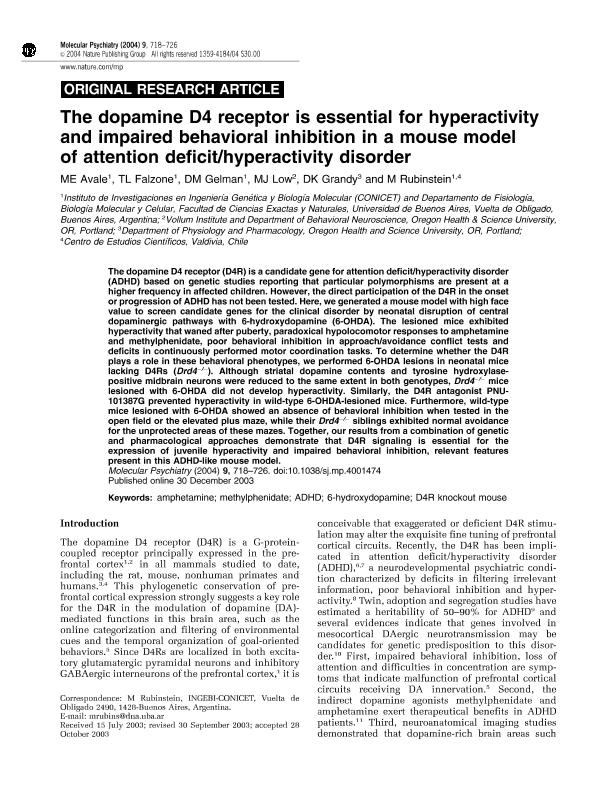Mostrar el registro sencillo del ítem
dc.contributor.author
Avale, Maria Elena

dc.contributor.author
Falzone, Tomas Luis

dc.contributor.author
Gelman, Diego Matias

dc.contributor.author
Low, Malcolm J.

dc.contributor.author
Grandy, David K.

dc.contributor.author
Rubinstein, Marcelo

dc.date.available
2019-07-17T18:09:53Z
dc.date.issued
2004-07
dc.identifier.citation
Avale, Maria Elena; Falzone, Tomas Luis; Gelman, Diego Matias; Low, Malcolm J.; Grandy, David K.; et al.; The dopamine D4 receptor is essential for hyperactivity and impaired behavioral inhibition in a mouse model of attention deficit/hyperactivity disorder; Nature Publishing Group; Molecular Psychiatry; 9; 7; 7-2004; 718-726
dc.identifier.issn
1359-4184
dc.identifier.uri
http://hdl.handle.net/11336/79753
dc.description.abstract
The dopamine D4 receptor (D4R) is a candidate gene for attention deficit/hyperactivity disorder (ADHD) based on genetic studies reporting that particular polymorphisms are present at a higher frequency in affected children. However, the direct participation of the D4R in the onset or progression of ADHD has not been tested. Here, we generated a mouse model with high face value to screen candidate genes for the clinical disorder by neonatal disruption of central dopaminergic pathways with 6-hydroxydopamine (6-OHDA). The lesioned mice exhibited hyperactivity that waned after puberty, paradoxical hypolocomotor responses to amphetamine and methylphenidate, poor behavioral inhibition in approach/avoidance conflict tests and deficits in continuously performed motor coordination tasks. To determine whether the D4R plays a role in these behavioral phenotypes, we performed 6-OHDA lesions in neonatal mice lacking D4Rs (Drd4-/-). Although striatal dopamine contents and tyrosine hydroxylase-positive midbrain neurons were reduced to the same extent in both genotypes, Drd4-/- mice lesioned with 6-OHDA did not develop hyperactivity. Similarly, the D4R antagonist PNU-101387G prevented hyperactivity in wild-type 6-OHDA-lesioned mice. Furthermore, wild-type mice lesioned with 6-OHDA showed an absence of behavioral inhibition when tested in the open field or the elevated plus maze, while their Drd4-/- siblings exhibited normal avoidance for the unprotected areas of these mazes. Together, our results from a combination of genetic and pharmacological approaches demonstrate that D4R signaling is essential for the expression of juvenile hyperactivity and impaired behavioral inhibition, relevant features present in this ADHD-like mouse model.
dc.format
application/pdf
dc.language.iso
eng
dc.publisher
Nature Publishing Group

dc.rights
info:eu-repo/semantics/openAccess
dc.rights.uri
https://creativecommons.org/licenses/by-nc-sa/2.5/ar/
dc.subject
6-Hydroxydopamine
dc.subject
Adhd
dc.subject
Amphetamine
dc.subject
D4r Knockout Mouse
dc.subject
Methylphenidate
dc.subject.classification
Otras Ciencias Biológicas

dc.subject.classification
Ciencias Biológicas

dc.subject.classification
CIENCIAS NATURALES Y EXACTAS

dc.title
The dopamine D4 receptor is essential for hyperactivity and impaired behavioral inhibition in a mouse model of attention deficit/hyperactivity disorder
dc.type
info:eu-repo/semantics/article
dc.type
info:ar-repo/semantics/artículo
dc.type
info:eu-repo/semantics/publishedVersion
dc.date.updated
2019-07-16T14:14:14Z
dc.journal.volume
9
dc.journal.number
7
dc.journal.pagination
718-726
dc.journal.pais
Reino Unido

dc.journal.ciudad
Londres
dc.description.fil
Fil: Avale, Maria Elena. Consejo Nacional de Investigaciones Científicas y Técnicas. Instituto de Investigaciones en Ingeniería Genética y Biología Molecular "Dr. Héctor N. Torres"; Argentina. Universidad de Buenos Aires. Facultad de Ciencias Exactas y Naturales. Departamento de Fisiología, Biología Molecular y Celular; Argentina
dc.description.fil
Fil: Falzone, Tomas Luis. Consejo Nacional de Investigaciones Científicas y Técnicas. Instituto de Investigaciones en Ingeniería Genética y Biología Molecular "Dr. Héctor N. Torres"; Argentina. Universidad de Buenos Aires. Facultad de Ciencias Exactas y Naturales. Departamento de Fisiología, Biología Molecular y Celular; Argentina
dc.description.fil
Fil: Gelman, Diego Matias. Consejo Nacional de Investigaciones Científicas y Técnicas. Instituto de Investigaciones en Ingeniería Genética y Biología Molecular "Dr. Héctor N. Torres"; Argentina. Universidad de Buenos Aires. Facultad de Ciencias Exactas y Naturales. Departamento de Fisiología, Biología Molecular y Celular; Argentina
dc.description.fil
Fil: Low, Malcolm J.. Oregon Health and Science University; Estados Unidos
dc.description.fil
Fil: Grandy, David K.. Oregon Health and Science University; Estados Unidos
dc.description.fil
Fil: Rubinstein, Marcelo. Consejo Nacional de Investigaciones Científicas y Técnicas. Instituto de Investigaciones en Ingeniería Genética y Biología Molecular "Dr. Héctor N. Torres"; Argentina. Universidad de Buenos Aires. Facultad de Ciencias Exactas y Naturales. Departamento de Fisiología, Biología Molecular y Celular; Argentina. Centro de Estudios Científicos; Chile
dc.journal.title
Molecular Psychiatry

dc.relation.alternativeid
info:eu-repo/semantics/altIdentifier/doi/http://dx.doi.org/10.1038/sj.mp.4001474
dc.relation.alternativeid
info:eu-repo/semantics/altIdentifier/url/https://www.ncbi.nlm.nih.gov/pubmed/14699433
dc.relation.alternativeid
info:eu-repo/semantics/altIdentifier/url/https://www.nature.com/articles/4001474
Archivos asociados
